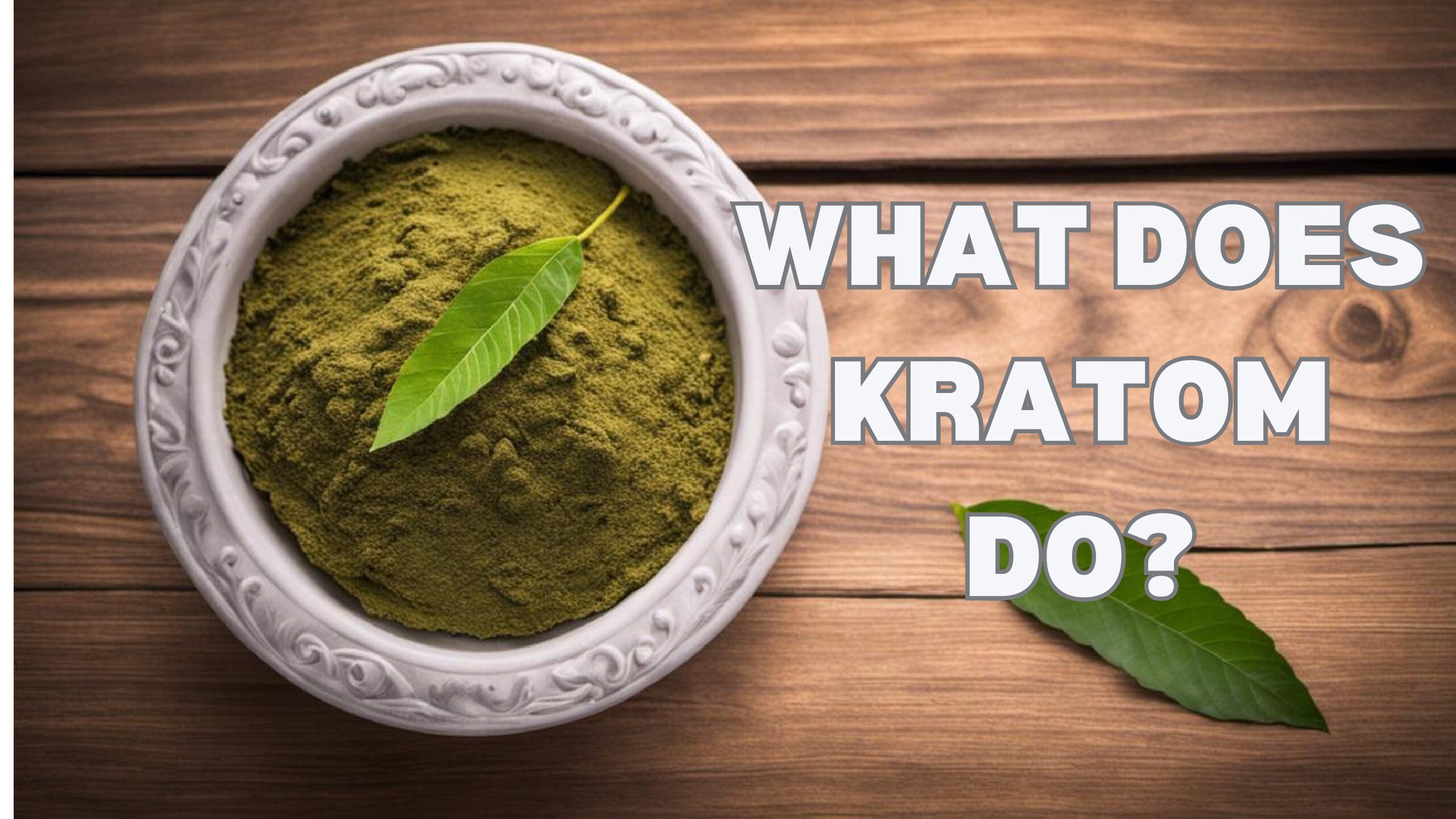WHAT DOES KRATOM DO?
Introduction
In the complex world of botanicals, one name that is gradually gaining more and more popularity is Kratom; a plant with potential therapeutic benefits and unique biochemical properties. Originating from Southeast Asia, Kratom has been utilized for centuries in traditional medicine, prized for its potential healing ability and mood-enhancing effects.
However, its rather contentious legal standing and the associated risks and side effects make it a subject that opens up discussions. To develop a better understanding, this post explores Kratom’s botanical lineage, its primary active compounds, and their effects on human physiology, along with a review of the potential benefits and risks tied to kratom usage.

WHAT DOES KRATOM DO?
One of the main reasons people use kratom is to manage pain. The active ingredients work similarly to opioids, hence it can provide temporary relief for everything from minor discomfort to severe chronic pain. Aside from its analgesic properties, some users consume kratom to combat fatigue, improve mood, and manage symptoms of depression or anxiety.
However, while kratom does boast several potential health benefits, it’s important to note that research is still ongoing. Some studies have identified potential harmful effects of long-term, high-dose usage, including weight loss, skin discoloration, insomnia, and hallucinations.
Understanding What Kratom Does

Kratom, bearing the scientific name Mitragyna speciosa, is a plant in the coffee family hailing from Southeast Asia. Its origin is traced back to countries like Thailand, Indonesia, Malaysia, and Papua New Guinea where it has been traditionally cultivated and utilized for centuries.
Kratom leaves were traditionally chewed or brewed into a tea and used as a stimulant by manual laborers in its native regions. This reflected its inherent properties to increase energy, improve focus and reduce pain, providing relief as a natural herbal remedy.
It is interesting to note the botanical nuances Kratom exhibits. The plant’s active compounds are alkaloids, predominantly mitragynine and 7-hydroxymitragynine, which interact with opioid receptors in the brain, causing sedative or stimulant effects depending on the dosage.
Small doses enhance energy and focus, while higher doses gear towards pain relief and induce a state of relaxation. In places of its origin, traditional usages included as a treatment for diarrhea, muscular pain and as an opium or heroin withdrawal aid.
In recent times, it has traveled beyond regional borders and has been incorporated into Western herbal medicine practices. However, legality remains variable globally.
In the U.S, it’s legal federally but has been banned in several states, while countries like Australia, Denmark, Finland, Israel, and Japan have mark it as a controlled substance. Due to the potential risks, including dependency and withdrawal symptoms, associated with kratom use, it remains a contentious issue in the medical and legal community.
You may also want to check out… IS KRATOM LEGAL?
Always remember, when introducing something new to your body, it is pivotal to have a clear understanding of it. Also, remember, it’s fundamental to reach out to healthcare experts before incorporating any new substance into your routine and ensure legalities in your area.
What Does Mitragynine and 7-Hydroxymitragynine Do?

Kratom operates primarily through its two primary components, Mitragynine and 7-Hydroxymitragynine, and their impact on the brain’s mu-opioid receptor. These receptors are typically engaged by opioids for their pain-relieving and euphoria-inducing effects.
When Kratom is consumed, it’s these two primary components that act upon the mu-opioid receptor, leading to feelings of pleasure, mood elevation, and relief from pain.
It’s important to note that the 7-Hydroxymitragynine compound boasts a greater potency than Mitragynine, triggering a stronger response from the receptor and thus intensifying the pain-relieving effect.
One key advantage of Kratom, compared to traditional opioids, is its tendency to leave respiratory functions less affected, a peculiarity that is owed to its interaction with other non-opioid receptors within the brain.

Potential Benefits and Risks of Kratom
The emerging body of research on kratom, a plant native to Southeast Asia, suggests several compelling benefits that have drawn many people to try it. Some of the main reputed advantages include pain relief and mood enhancement. These effects can be attributed to kratom’s unique chemical compounds that interact with opioid receptors within our brain to potentially lessen our perception of pain.
Regular users of kratom often report feelings of euphoria, as well as marked improvements in symptoms of anxiety and depression. Beyond these effects, the same qualities that make kratom effective for pain management may also prove invaluable in the realm of addiction treatment. For some, the plant’s interaction with opioid receptors has been effective in helping to lessen dependence on stronger, potentially dangerous, opiates.
You may also want to check out the post: IS IT OKAY TO USE KRATOM EVERY DAY?
Risks and Side-Effects of Kratom
While kratom may offer these potential benefits, it’s essential to also consider the associated risks and side effects. Even though it interacts with opioid receptors, kratom is not an opioid. Therefore, it can produce a range of unwanted side effects typically associated with opioid use, such as nausea, sweating, seizures, and even hallucinations.
Additionally, heavy use of kratom can lead to dependency. Dependency can result in withdrawal symptoms when one stops using the substance. These symptoms can include irritability, muscle aches, aggression, emotional changes, and in some reported cases, hostility.
Furthermore, due to its relatively recent arrival on the Western market, the long-term effects of kratom use are still widely unknown, suggesting a degree of caution is necessary when considering its use.
You may also want to check out the post titled: CAN YOU BE ADDICTED TO KRATOM?
CONCLUSION
The super plant known as Kratom, embodies a paradox of potential therapeutic advantages, such as pain relief and mood elevation, yet possible side effects, such as dependency, which all serve as a stark reminder of life’s dual facets.
It urges a need for further research, responsible usage, and regulatory procedures to harness its potential while also mitigating possible adverse effects. The story of Kratom continues to unfold as more research unfolds, showcasing its mysterious nature, and underscoring the importance of knowledge and understanding in the realm of natural therapeutics.
-The Educated Felon
You may also want to check out these other posts….
WILL KRATOM MAKE YOU FAIL A DRUG TEST?
DOES KRATOM AFFECT YOUR PROBATION?
WHERE CAN I GET GOOD-QUALITY KRATOM?








One Comment